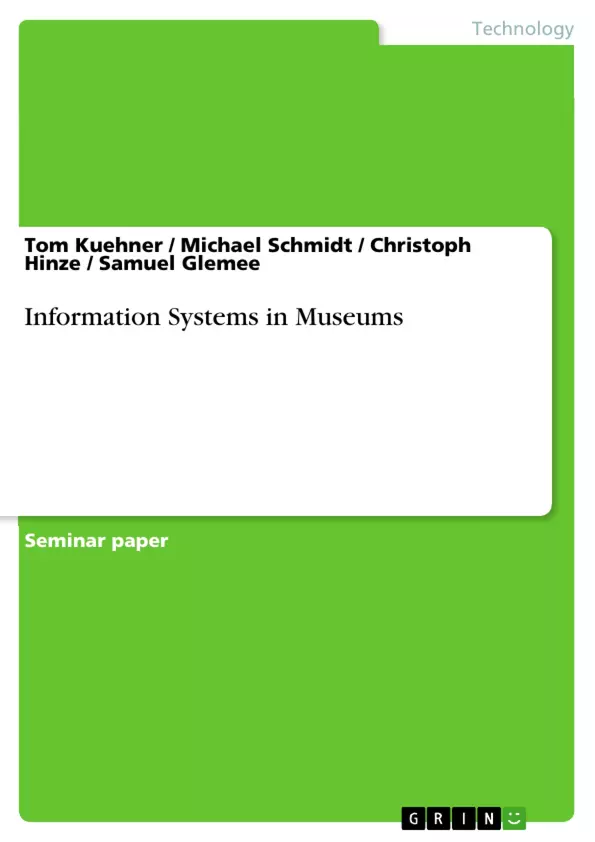In almost every part of modern life we have contact with different information systems. In the last few decades the computer became a more and more important medium for collecting, structuring and providing of information. A relative new invention is the possibility to locate a certain device in the physical space. It was originally developed for military purposes, but comes now to a broader application in the private and public sector. As a rather specific but never the less significant example we would like to present a connection of computing in one of its latest appearances and the possibility of locating devices connected to a totally new kind of information system. We would like to introduce the use of handheld computers for the use of a push/pull information system in the context of an exhibition or museum. Automation technologies were introduced to museums in the early 1960s. Projects like SELGEM (Self Generating Master) involved several museums and supported data entry to track collection information. Large scale computer use by museums was not feasible at that time because early computers were expensive and required space for installation. But that would change quickly. In 1968 Hewlett-Packard released its first programmable calculators. The early machines, such as the HP-9100, weighed 40 pounds and might be considered the first desktop computers. While Texas Instruments is credited with inventing the first pocket calculator in 1967, Hewlett-Packard developed the first programmable pocket calculator in 1974. After a NASA mission, the pocket HP-65 was promoted as having served "as a backup for Apollo's on-board computer." In ten years programmable computers had evolved from filling rooms to fitting in pockets.
While pocket computers may have found immediate use in museum offices, evidence of pocket computers enhancing the visitor experience was not found. The use of hand helds in museum exhibitions seems to have been inspired by the early personal digital assistants (PDAs) such as the Zaurus, Psion, and Newton. In 1993 two young men formed a company, Visible Interactive, around their modification of the Apple Newton they called iGo. Promoting it as the “world’s first interactive audio tour” their idea was to provide museum visitors with an enhanced personal experience through the accessibility of multimedia, text, and audio while walking through an exhibit space. [...]
Table of Contents
- Introduction
- Introduction
- A brief recent history
- Printed information-systems_
- Acoustic information systems_
- Information systems with use of computers.
- HIPS Hyper Interaction within Physical Space
- A school visit scenario
- Features of portable information systems
- Advantages
- Disadvantages
- Conclusion
- References
Objectives and Key Themes
This text explores the evolution of information systems in museums, focusing on the introduction and impact of handheld computers. It examines the development of these technologies and their use in enhancing visitor experience, highlighting the challenges and opportunities associated with their implementation.
- The history of information systems in museums
- The emergence of handheld computers and their application in museum exhibits
- The advantages and disadvantages of using portable information systems in museums
- Challenges and lessons learned from early implementations of portable information systems in museums
- The potential and future of handheld devices in enhancing visitor experience
Chapter Summaries
- Introduction: This chapter sets the stage by introducing the topic of information systems in museums and highlighting the growing importance of handheld computers in this context. It provides a brief historical overview of automation technologies in museums, emphasizing the transition from large, room-filling computers to smaller, more portable devices.
- A brief recent history: This chapter delves deeper into the history of handheld computers in museums, tracing their evolution from early personal digital assistants (PDAs) to the Newton and Rocket eBook. It discusses the challenges and successes of various pilot projects that employed these devices to enhance visitor experience.
- Printed information-systems_: This chapter explores the use of printed materials as information systems in museums, highlighting their advantages and limitations. It likely discusses the evolution of printed guides and their role in providing information to visitors.
- Acoustic information systems_: This chapter examines the use of audio-based information systems in museums, including audio guides and multimedia presentations. It likely discusses the benefits and drawbacks of using sound as a medium for conveying information to visitors.
- Information systems with use of computers.: This chapter focuses on the integration of computers into museum information systems. It likely discusses the development of interactive exhibits, digital displays, and other computer-based technologies used to enhance visitor engagement.
- HIPS Hyper Interaction within Physical Space: This chapter delves into the concept of HIPS (Hyper Interaction within Physical Space), showcasing how handheld computers can be integrated into museum exhibits to create dynamic and personalized experiences for visitors.
- Features of portable information systems: This chapter examines the advantages and disadvantages of using portable information systems in museums, focusing on their impact on visitor experience, accessibility, and manageability. It likely discusses factors such as cost, durability, ease of use, and potential security concerns.
Keywords
This text explores the use of handheld computers in museums, examining the development of portable information systems, their advantages and disadvantages, and the challenges of implementing them in a museum setting. Key themes include the history of information systems in museums, the evolution of handheld devices, visitor experience, and the integration of technology into museum exhibits.
- Quote paper
- Tom Kuehner (Author), Michael Schmidt (Author), Christoph Hinze (Author), Samuel Glemee (Author), 2003, Information Systems in Museums, Munich, GRIN Verlag, https://www.grin.com/document/18074



